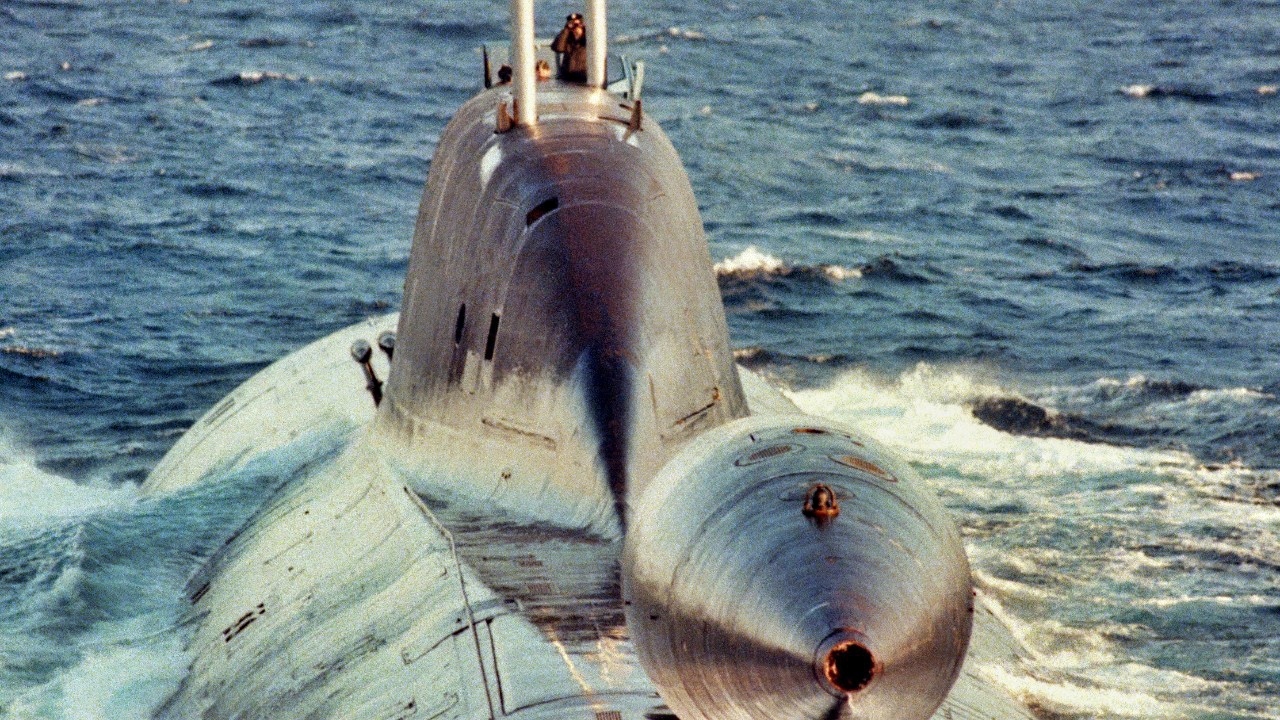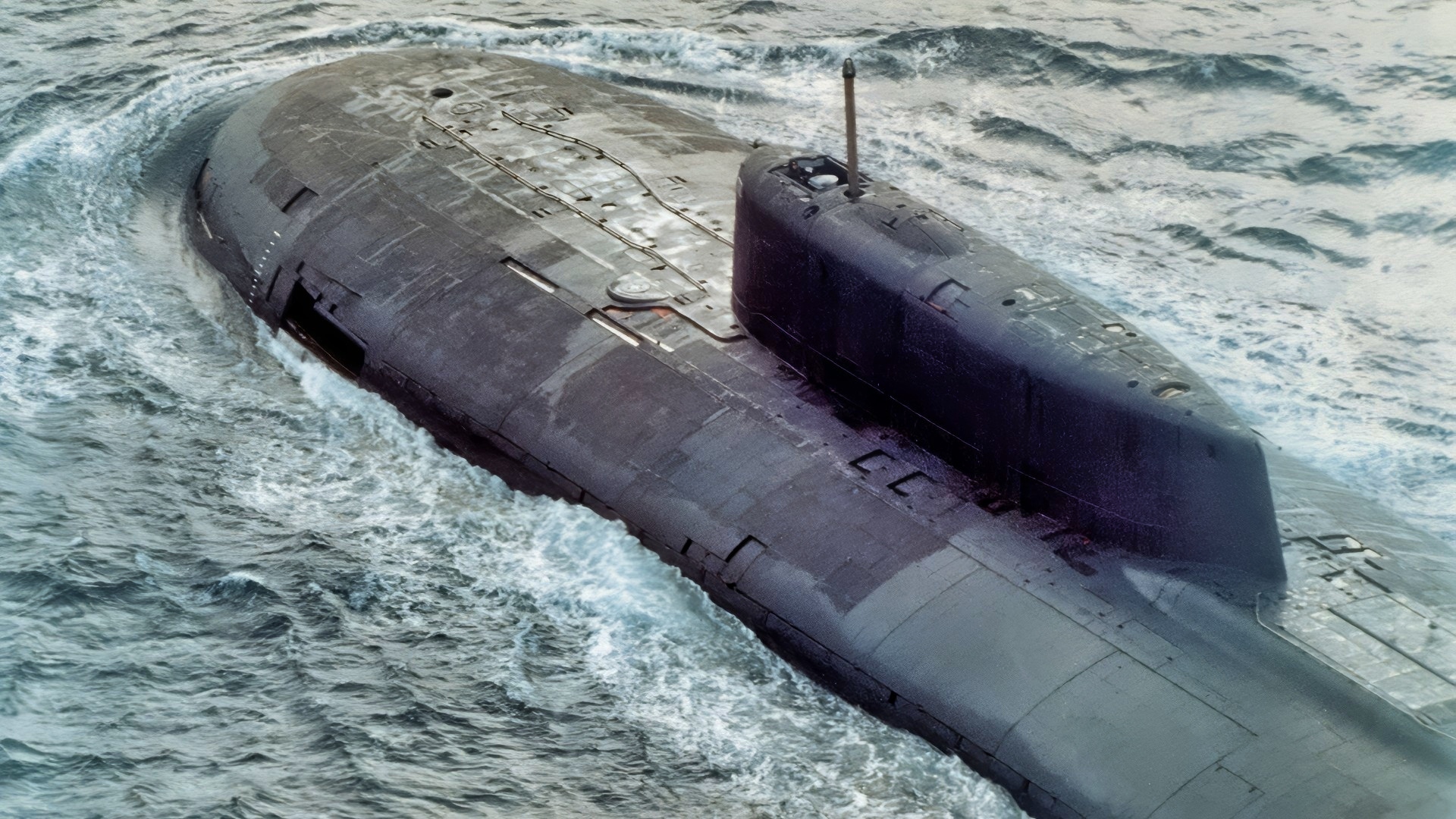Key Points and Summary – Days after announcing a test of his “Flying Chernobyl” missile, Vladimir Putin claimed a new “successful test” of the Poseidon “doomsday” weapon, an autonomous, nuclear-powered, nuclear-armed torpedo.
-Putin, in a staged meeting with elite soldiers, boasted the weapon is “unmatched,” “un-interceptable,” and powered by a reactor 100 times smaller than a sub’s.

An aerial stern-on view of the Russian Northern Fleet AKULA class nuclear-powered attack submarine underway on the surface. Image Credit: Creative Commons.
-This latest claim is seen by Western experts as pure “nuclear signaling” to President Trump, an attempt by Putin to project strength and justify his “maximalist demands” in Ukraine, even as his conventional military is collapsing.
Poseidon Nuclear “Doomsday” Torpedo: The Real Deal Threat?
President Vladimir Putin has just recently announced the test of another one of Russia’s nuclear doomsday weapons.
This news comes only three days after the supposed successful flight of the 9M730 Burevestnik, a nuclear-powered cruise missile also equipped with an onboard nuclear propulsion system.
This latest weapon is another one of a package of nuclear holocaust devices that Vladimir Putin first presented in March 2018.
The Russian President, a former KGB lieutenant colonel, unveiled CGI-generated photos and videos of this weaponry during his annual State of the Nation address to a joint session of the Russian parliament.
The system that Putin claims Russia successfully tested this week was a new nuclear-powered, nuclear-capable underwater robot, the Oceanic Multipurpose System (OMS), previously known as “Status-6” and System 2M39, and more recently referred to as Poseidon.
The Poseidon is an autonomous, nuclear-powered, unmanned underwater vehicle that is reportedly in production at the St. Petersburg Rubin Design Bureau. The design bureau (OKB) is the same institution that was responsible for the design of many of the USSR—including the famous Typhoon-class—and later leading submarines produced in Russia.
The vehicle is described as being capable of delivering both conventional and nuclear warheads at any target anywhere on the globe. Putin has also declared that the new weapon cannot be intercepted.

Akula-Class. Image Credit: Creative Commons.

Akula-Class Submarine from Russian Navy. Image Credit: Creative Commons.
Nuclear-Signalling
Putin’s announcement appears to be another act of nuclear signaling, a message to US President Donald Trump.
The interpretation is that the Kremlin, unable to make any breakthroughs on the battlefield in Ukraine, is instead trotting out these programs, announced seven years ago, to show that Moscow still retains considerable military prowess, albeit in the nuclear sphere.
“What Putin wants to telegraph,” said a retired US intelligence official, “is despite Russia appearing to have a collapsing military establishment and an industrial capacity being regularly degraded by Ukrainian drone strikes, it is by no means a ‘paper tiger’, as US President Trump had said.
“However, Putin is telling us he still has enough wunderwaffe-type projects that have been on the shelf that he can now showcase to justify his continuing to maintain the same maximalist demands on Ukraine—the same that he has spouted since Day One of the invasion.”
As if to openly connect these esoteric weapon systems with the Ukraine war, Putin made sure that he announced the successful test of the Poseidon while meeting with Russian soldiers wounded in Ukraine. A careful inspection of the photo reveals that the uniforms belong to soldiers from elite Spetsnaz (special forces) units, not typical soldiers serving on the front lines.
The Russian president also decorated these servicemen during his visit to the Pyotr Mandryk Central Military Clinical Hospital. Russian Defense Minister Andrei Belousov accompanied him on his visit.
“Also notice that the soldiers are being treated at an elite medical centre in the capital and not at some primitive makeshift field hospital in Eastern Ukraine where units suffer more than a 1000 dead per week,” said the former intelligence official. “This was a staged event—with the group of servicemen being decorated for combat service. But most of them were being used as props as they appeared to not have suffered not so much as a scratch.”
“This contrasts with stories about the frontline units that experience as high as 95 per cent casualties in a single attack. It is an effort to convince the public that the war is not the bloody killing field and meat grinder that it really is.”
Miniature-Size, Maximum-Yield Nuclear Weapons
Putin told the assembled soldiers that the Poseidon drone was tested on Tuesday, running on nuclear power for the first time. He described it as unmatched in speed and depth.
Russian media reports stated that the Poseidon is designed to travel at a speed of up to 200 kph (124 mph), significantly faster than any existing torpedoes or warships. With nuclear power providing it with an unlimited range, the drone’s speed and depth make it difficult for an enemy to locate.
“For the first time, we managed not only to launch it from its carrier submarine … but also to activate its nuclear power unit, allowing the vehicle to operate for a certain period of time,” Putin said.
“In terms of speed and operating depth, there is nothing like this unmanned vehicle anywhere in the world, and it’s unlikely that anything similar will appear in the near future. And there is no way to intercept it.”
Putin stated that the nuclear reactor that powers Poseidon is “100 times smaller” than those used on board manned submarines. The power of the nuclear warhead of this weapon is “significantly higher than that of our most advanced Sarmat intercontinental ballistic missile,” said the former KGB Lt. Col.
When Putin first mentioned the underwater nuclear-powered drone in his 2018 State of the Nation address, he outlined that the system was designed to explode near coastlines and “unleash a powerful radioactive tsunami.”
Another way to start doomsday – only this time from the sea rather than from something flying overhead.
About the Author: Reuben F. Johnson
Reuben F. Johnson has thirty-six years of experience analyzing and reporting on foreign weapons systems, defense technologies, and international arms export policy. Johnson is the Director of the Asia Research Centre at the Casimir Pulaski Foundation. He is also a survivor of the Russian invasion of Ukraine in February 2022. He worked for years in the American defense industry as a foreign technology analyst and later as a consultant for the U.S. Department of Defense, the Departments of the Navy and Air Force, and the governments of the United Kingdom and Australia. In 2022-2023, he won two awards in a row for his defense reporting. He holds a bachelor’s degree from DePauw University and a master’s degree from Miami University in Ohio, specializing in Soviet and Russian studies. He lives in Warsaw.
More Military
China’s H-20 Stealth Bomber Has a Message for the U.S. Air Force
China’s New J-35 Stealth Fighter Has a Message for the U.S. Air Force
China Is Studying the Ukraine War to Become a Drone Superpower
The Road to a China-America Nuclear War
China Could Fire Mach 6 Hypersonic Missiles from Bombers to Sink Navy Aircraft Carriers










